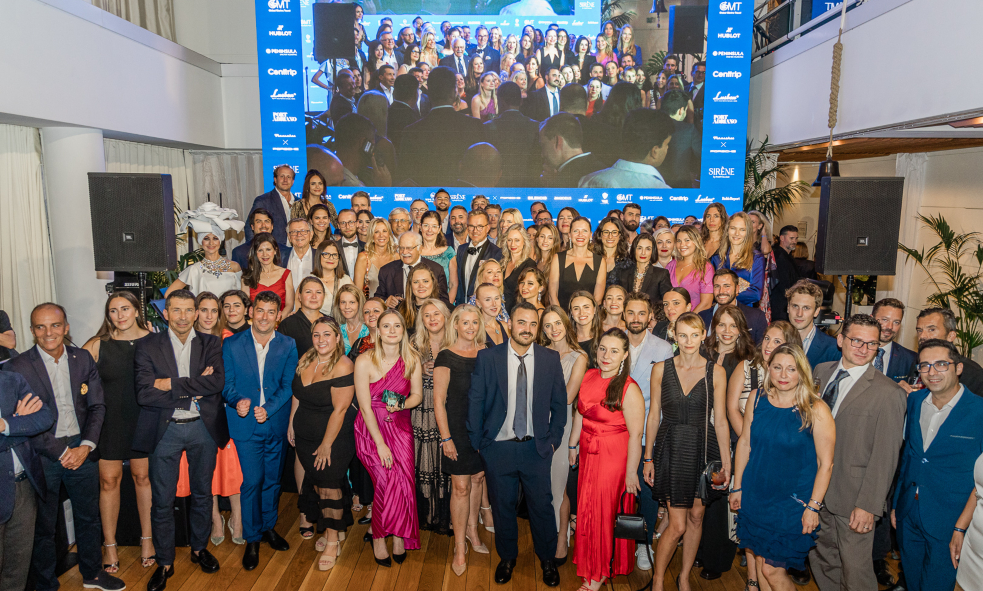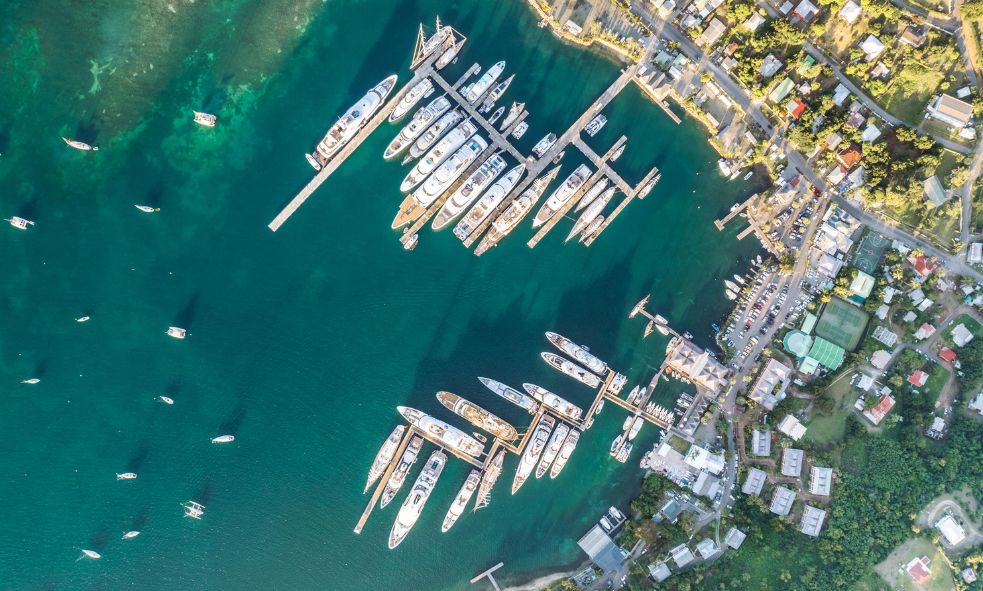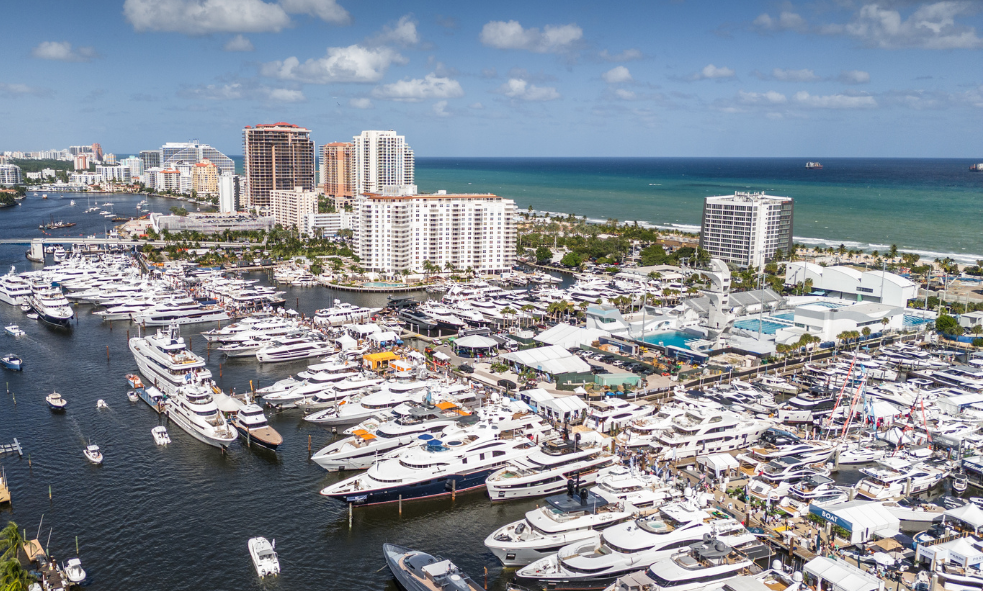Artefact Captain Aaron T. Clark on bringing an owner's dream to life with the multi award-winning Nobiskrug
A full eighteen months after ARTEFACT hit the water, Captain Aaron T Clark found himself standing on the deck, looking at the yacht he had worked for seven years to build, and thinking, for the first time: “This is awesome”.
“I was cruising around in the middle of the ocean, and I caught myself smiling,” he remembers. “It took me a year and a half before I was really able to stand back and absorb it all. The world is very impatient for instant gratification, but after we first launched I was still remembering everything it took to make the yacht, asking myself: is it working for the Owner and his guests? Is it working for the crew? Is the vision of it working? Finally I could say: this works.”
As descriptions go, awesome is no hyperbole when it comes to 80M/262‘ ARTEFACT. From her groundbreaking use of glass — 720 square metres, 58 tons and 223 pieces in total — to her innovative diesel-electric propulsion system which results in exceptionally quiet cruising to her dynamic positioning system, she smashes every boundary of possibility in yachting.
Since her launch in 2020, she has won more awards than any other yacht in history — a replica set of which the Owner had made for Aaron, telling him: “These are your awards”. His comment was a recognition of just how crucial the role of Build Captain is to the successful design, construction, launch and ongoing operation of a yacht as unique as ARTEFACT. The yacht‘s motto: The perfect marriage of art and science.
“I was cruising around in the middle of the ocean, and I caught myself smiling,” he remembers. “It took me a year and a half before I was really able to stand back and absorb it all. The world is very impatient for instant gratification, but after we first launched I was still remembering everything it took to make the yacht, asking myself: is it working for the Owner and his guests? Is it working for the crew? Is the vision of it working? Finally I could say: this works.”
As descriptions go, awesome is no hyperbole when it comes to 80M/262‘ ARTEFACT. From her groundbreaking use of glass — 720 square metres, 58 tons and 223 pieces in total — to her innovative diesel-electric propulsion system which results in exceptionally quiet cruising to her dynamic positioning system, she smashes every boundary of possibility in yachting.
Since her launch in 2020, she has won more awards than any other yacht in history — a replica set of which the Owner had made for Aaron, telling him: “These are your awards”. His comment was a recognition of just how crucial the role of Build Captain is to the successful design, construction, launch and ongoing operation of a yacht as unique as ARTEFACT. The yacht‘s motto: The perfect marriage of art and science.

What motived this Owner to create something not just unique, but so far beyond anything that has been achieved before? “Not to look like all the other boats! To look cutting edge. But also, when you look at this boat you think, wow — that is a diesel-electric boat. From just looking at it, you know it doesn’t have conventional drive systems: you know there is something interesting going on,” says Aaron.
And while ARTEFACT is a future-proof yacht in terms of tech, the same is true of its guest experience. “My advice to an Owner is always to build a yacht he and his family can grow into,” he says. “We are all very conscious of the environment now: to have one yacht over your lifespan, and improve on that, is so much better.
The other thing that a lot of people forget is that we are here for memories. If you have a yacht for 20 years and you do it properly, imagine the memories you can get with your friends and family. There is so much invested into it over time that it’s a connection to the enjoyment you get out of life.”
And while ARTEFACT is a future-proof yacht in terms of tech, the same is true of its guest experience. “My advice to an Owner is always to build a yacht he and his family can grow into,” he says. “We are all very conscious of the environment now: to have one yacht over your lifespan, and improve on that, is so much better.
The other thing that a lot of people forget is that we are here for memories. If you have a yacht for 20 years and you do it properly, imagine the memories you can get with your friends and family. There is so much invested into it over time that it’s a connection to the enjoyment you get out of life.”

What did the Owner want from his onboard experience? Firstly, a self-sufficient, live-aboard vessel that he could spend long periods of time on with his family. His first trip on board, for example, lasted four months.
“We’ve got really good spaces for the Owners to not feel they’re in the same space all the time,” says Aaron. “We mix up what they do so they spread through the boat. They read a lot, spend time together, watch movies, play games. We go fishing, do water sports, go swimming. You can do so many activities that it never gets boring.”
ARTEFACT even has a craft room for the Owner’s wife, complete with sewing machines and 3D printers. “They spend a lot of time there,” says Aaron. “It’s nice to have a designated area when you’re living aboard.”
“We’ve got really good spaces for the Owners to not feel they’re in the same space all the time,” says Aaron. “We mix up what they do so they spread through the boat. They read a lot, spend time together, watch movies, play games. We go fishing, do water sports, go swimming. You can do so many activities that it never gets boring.”
ARTEFACT even has a craft room for the Owner’s wife, complete with sewing machines and 3D printers. “They spend a lot of time there,” says Aaron. “It’s nice to have a designated area when you’re living aboard.”

Another element was ultra-quiet cruising, a requirement that impacted not only the propulsion choice but the exterior and interior design too. Even the artistic detailing was chosen for sound dampening, thanks to the work of a specialist sound engineer who used techniques already put in place at the Owner’s home.
“It’s very discreet through the vessel, but with all the glass, we have to pay attention to that — there is no reverberation anywhere,” says Aaron. “The Owners can enjoy the guest spaces, reading or being together, knowing that they are not going to be disturbed even by the noise of footsteps. Even the Owner, who has nice big private homes, says his homes aren’t anywhere near as good as the boat for privacy.”
“It’s very discreet through the vessel, but with all the glass, we have to pay attention to that — there is no reverberation anywhere,” says Aaron. “The Owners can enjoy the guest spaces, reading or being together, knowing that they are not going to be disturbed even by the noise of footsteps. Even the Owner, who has nice big private homes, says his homes aren’t anywhere near as good as the boat for privacy.”
Those 720 square metres of glass pay off for views of the world outside, too, with far better panoramas through these oversized windows than most vessels. It’s something Aaron also harnesses to keep the Owner experience ever-changing: “We'll arrive somewhere in the morning, and I‘ll find a beautiful place where the sun's shining.
The Owner's bathroom on the port side, and his wife’s on the other side, both have full-height glass. So in the morning when I know he is not out of his cabin, I‘ll pull up and sit in that position with the port side facing the spectacular view. And about the time I know he gets to his office, I just turn the boat, on dynamic positioning, to the front so he sees it from there. Then when I know his wife is getting up and will be in the bathroom, I‘ll turn the boat again to capitalise on the view on the starboard side.” It is just an example of how the imagination of a top Captain and the right vessel can make a guest experience better than they imagined.
The Owner's bathroom on the port side, and his wife’s on the other side, both have full-height glass. So in the morning when I know he is not out of his cabin, I‘ll pull up and sit in that position with the port side facing the spectacular view. And about the time I know he gets to his office, I just turn the boat, on dynamic positioning, to the front so he sees it from there. Then when I know his wife is getting up and will be in the bathroom, I‘ll turn the boat again to capitalise on the view on the starboard side.” It is just an example of how the imagination of a top Captain and the right vessel can make a guest experience better than they imagined.
As Aaron says: “I think the biggest thing the Owners have learned from the boat is how it keeps giving the experience in different ways. Just when you think it plateaus, we do something slightly different and they go ‘wow, that is really special and really enjoyable’. How they use the boat is still evolving, every day.”

So how did ARTEFACT evolve into what it is now? At the start, says Aaron, it was a blank sheet of paper. “The boat wasn't the boat for a long, long time,” he says. “The Owner and I worked together for 18 months trying to define what we wanted the boat to be. We looked at different designs, from catamarans to high-speed displacement vessels. He was a first-time yacht Owner, so we had to start from the beginning, which was really good because he didn't have any preconceived or restrictive experiences. We had a bit more freedom.”
The Owner’s engineering background also made a world of difference. “Engineers come with a different approach — you can talk easily, down to saying ‘don’t put gold taps on’. The Owner was so involved in the research and development, everything through to the propulsion. Even when we did tank testing, he came to the facility. He loves this stuff!”
The Owner’s engineering background also made a world of difference. “Engineers come with a different approach — you can talk easily, down to saying ‘don’t put gold taps on’. The Owner was so involved in the research and development, everything through to the propulsion. Even when we did tank testing, he came to the facility. He loves this stuff!”

Once they had found a designer in Gregory C Marshall and developed the concept with him, the next step Aaron suggested was unusual, but proved key to the successful final product: a full-scale walkthrough mock-up, made out of timber and builders’ paper.
“We built the whole Owner’s level — you could walk through it for 60 metres. It had all the recesses in the ceiling, we even built the storage, the galley, the service pantries. We mocked up the table size. It allowed the Owner and his family to feel the space and say: ‘yes, this works’ or ‘let’s change this’.” They even walked around drawing in light switches and power outlets.A key added value to this step? Significant cost saving. “People do virtual reality and computerisation, but you don’t get the feel. And it costs about $400,000 to do that: what I did cost $110,000.”
Only after this step did the Owner and Aaron decide the hull size. Unlike most builds, says Aaron: “We didn’t think: this is how big the boat is and this is what we are going to fit into it”. It was worth it.“After the mock-up exercise, we extended the hull by 5M/16’ and the volume increased by 600 GT.” Aaron and the Owner chose Nobiskrug for its willingness at the time (2014) to challenge convention and its work on naval vessels, electric submarines and other types of vessel.
“We built the whole Owner’s level — you could walk through it for 60 metres. It had all the recesses in the ceiling, we even built the storage, the galley, the service pantries. We mocked up the table size. It allowed the Owner and his family to feel the space and say: ‘yes, this works’ or ‘let’s change this’.” They even walked around drawing in light switches and power outlets.A key added value to this step? Significant cost saving. “People do virtual reality and computerisation, but you don’t get the feel. And it costs about $400,000 to do that: what I did cost $110,000.”
Only after this step did the Owner and Aaron decide the hull size. Unlike most builds, says Aaron: “We didn’t think: this is how big the boat is and this is what we are going to fit into it”. It was worth it.“After the mock-up exercise, we extended the hull by 5M/16’ and the volume increased by 600 GT.” Aaron and the Owner chose Nobiskrug for its willingness at the time (2014) to challenge convention and its work on naval vessels, electric submarines and other types of vessel.

ARTEFACT’s technology and sustainability credentials are revolutionary. Her advanced DC bus digital power management system was the first to be installed on a yacht, and allows the vessel to fully integrate multiple sources of power from solar cells, variable-speed generators and lithium batteries. The yacht also offers vibration-reducing Azipods.
“Sustainability to me is to minimise ongoing environmental impacts and costs on board hand in hand. A lot of people do environmental initiatives, but they are unrealistic. We took technologies from the commercial industry that are environmentally friendly and make economic sense."
"We use less fuel because we have a variable DC bus. We slow the RPMs down and only burn what we need. Plus we couple it up to batteries making us more efficient with our load. We run one engine to do everything and it makes a big difference: while most yachts use around 1,200 engine hours on a Transatlantic crossing, we use just 400. You can design a boat to be more efficient, not just for the environment but for the downtime and the maintenance periods.”
Being armed at the start with all this research, both from Aaron and the Owner and from the shipyard, meant that by the end of it, total change orders were just 1.1% (compared to 30% normally). “Something that happened with this boat is it shows it can be done really well. You do wonder why the rest of the industry is stunted in what we have the privilege of trying to achieve.”
“Sustainability to me is to minimise ongoing environmental impacts and costs on board hand in hand. A lot of people do environmental initiatives, but they are unrealistic. We took technologies from the commercial industry that are environmentally friendly and make economic sense."
"We use less fuel because we have a variable DC bus. We slow the RPMs down and only burn what we need. Plus we couple it up to batteries making us more efficient with our load. We run one engine to do everything and it makes a big difference: while most yachts use around 1,200 engine hours on a Transatlantic crossing, we use just 400. You can design a boat to be more efficient, not just for the environment but for the downtime and the maintenance periods.”
Being armed at the start with all this research, both from Aaron and the Owner and from the shipyard, meant that by the end of it, total change orders were just 1.1% (compared to 30% normally). “Something that happened with this boat is it shows it can be done really well. You do wonder why the rest of the industry is stunted in what we have the privilege of trying to achieve.”
What’s ahead for this truly unique yacht? Adventures in Galapagos, Panama, Costa Rica, Alaska, Fiji and New Zealand beckon — and the future looks extraordinary.







